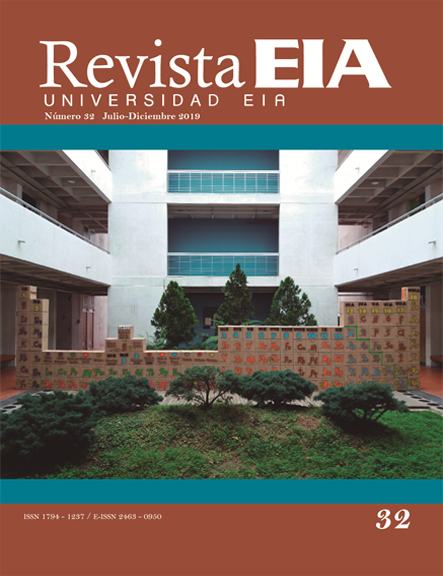Intervención tecnológica para la reconversión y automatización de una máquina termoformadora por vacío de una sola estación
Intervención tecnológica para la reconversión y automatización de una máquina termoformadora por vacío de una sola estación
Barra lateral del artículo
Términos de la licencia (VER)
Declaración del copyright
Los autores ceden en exclusiva a la Universidad EIA, con facultad de cesión a terceros, todos los derechos de explotación que deriven de los trabajos que sean aceptados para su publicación en la Revista EIA, así como en cualquier producto derivados de la misma y, en particular, los de reproducción, distribución, comunicación pública (incluida la puesta a disposición interactiva) y transformación (incluidas la adaptación, la modificación y, en su caso, la traducción), para todas las modalidades de explotación (a título enunciativo y no limitativo: en formato papel, electrónico, on-line, soporte informático o audiovisual, así como en cualquier otro formato, incluso con finalidad promocional o publicitaria y/o para la realización de productos derivados), para un ámbito territorial mundial y para toda la duración legal de los derechos prevista en el vigente texto difundido de la Ley de Propiedad Intelectual. Esta cesión la realizarán los autores sin derecho a ningún tipo de remuneración o indemnización.
La autorización conferida a la Revista EIA estará vigente a partir de la fecha en que se incluye en el volumen y número respectivo en el Sistema Open Journal Systems de la Revista EIA, así como en las diferentes bases e índices de datos en que se encuentra indexada la publicación.
Todos los contenidos de la Revista EIA, están publicados bajo la Licencia Creative Commons Atribución-NoComercial-NoDerivativa 4.0 Internacional
Licencia
![]()
Esta obra está bajo una Licencia Creative Commons Atribución-NoComercial-NoDerivativa 4.0 Internacional
Contenido principal del artículo
Resumen
Este artículo presenta el proceso de reconversión y automatización de una máquina de termoformado por vacío, de una sola estación y de operación manual, partiendo de un diagnóstico con el cual se identifican los componentes, capacidades y operación de los sistemas y su accionar como conjunto; se facilita elaborar el rediseño de los sistemas mecánico y neumático y el diseño de los sistemas térmico, eléctrico y de control, para la fabricación, ensamble y puesta a punto. Con la termoformadora automatizada fue posible el funcionamiento secuencial para trabajo en serie con temperaturas controladas, niveles superiores de calentamiento, disminución del consumo energético y una adecuada interacción máquina-operario para el ajuste de las variables y la caracterización del proceso de termoformado sobre cada material. La actualización y automatización propuesta para este tipo de máquinas representa una alternativa de capacidad tecnológica con un importante beneficio potencial para las pequeñas empresas del sector de formado de plástico.
Descargas
Detalles del artículo
Juan José Arbeláez Toro, Instituto Tecnológico Metropolitano
Docente area de ingenieríaReferencias (VER)
Albadawi, Z., Boulet, B., DiRaddo, R., Girard, P. and Thomson, V. (2006). Agent-based control for thermoforming processes. 12th IFAC/IFIP/IFORS/IEEE/IMS Symposium Information Control Problems in Manufacturing, Saint-Etienne, France, 17-19 May 2006, pp. 465-470. –Disponible en: http://www.emse.fr/incom06/publication.html [Consultado 21 de abril 2017].
Bhattacharyya D., Bowis M. and Jayaraman, K. (2003). Thermoforming woodfibre–polypropylene composite sheets. Composites Science and Technology, 63, April, pp. 353-363.
DiRaddo, R. W., & Meddad, A. (2000). Sensitivity of operating conditions and material properties for thermoforming process. Plastics, rubber and composites, 29(4), pp 163-167.
Drobney, J. G., (2007). Handbook of thermoplastic elastomers. New York: William Andrew Inc., pp. 216-217.
Dua, C., Chenb, S. and Lianga, X. (2011). Application of Fuzzy theory in temperature control system of thermoforming machine. Advanced in Control Engineering and Information Science, 15(1), pp. 639-643.
Dubois, J. H. (1972). Plastics history. Boston, MA: Cahners Books, pp. 73-74.
Engelmann, S. (2012). Advanced thermoforming: methods, machines and materials, applications and automation. 8th, New Jersey: John Wiley & Sons, pp. 75-79.
Funck, R., & Neitzel, M. (1995). Improved thermoplastic tape winding using laser or direct-flame heating. Composites Manufacturing, 6(1), pp 189-192.
Gauthier, G., & Boulet, B. (2006). Terminal iterative learning control applied to thermoforming machine reheat phase. In Industrial Electronics, 2006 IEEE International Symposium on Industrial Electronics, Montreal, QC, Canada 09-13 July 2006.-Disponible en:https://www.ieee.org/conferences_events/conferences/conferencedetails/index.html?Conf_ID=11163 [Consultado 5 de mayo 2017].
Girard, P., Di Raddo, R., Thomson, V., & Boulet, B. (2005). Advanced in-cycle and cycle-to cycle on-line adaptive control for thermoforming of large thermoplastic sheets. SAE Technical Paper, [e-journal]. https://doi.org/10.4271/2005-01-1520.
Klein, P. (2009). Fundamentals of plastics thermoforming. Synthesis Lectures on Materials Engineering, 1(1), pp 1-97.
Kutz M. (2011), Applied plastics engineering handbook processing and material. 2nd ed. New York: William Andrew Inc, pp. 95-96.
Li, Z. Z., Ma, G., Xuan, D. J., Seol, S. Y., & Shen, Y. D. (2010). A study on control of heater power and heating time for thermoforming. International Journal of Precision Engineering and Manufacturing, 11(6), pp 873-878.
Ming, P., Meng, P., Wen, C. and Ishak, Z. (2014). Carbon footprint calculation for thermoformed starch-filled polypropylene biobased materials. Journal of Cleaner Production, 64, pp. 602-608.
Rosen, S. R. (2002). Thermoforming: improving process performance, Dearborn, Michigan: Society of Manufacturing Engineers, pp 274-275.
Throne, J. L. (2008). Understanding thermoforming. 2nd ed, Dunedin: Hanser Gardner Publications, pp. 171-176.
Wiesche, S. (2004). Industrial thermoforming simulation of automotive fuel tanks. Applied thermal engineering, 24, April, pp. 2391-2409.
Zhang, Z. G., Lin, C., Feng, D. K., & Still, R. (2010). Improving plastic thermoform quality with Uniform Heating Technology. In Advanced Materials Research, 97(1), pp. 204-208.


 PDF
PDF
 FLIP
FLIP







